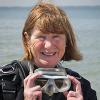
On a gloomy day in October 1982, Henry VIII's flagship Mary Rose finally broke the surface of the Solent after 400 years underwater. Three days of events are taking place this October to mark the forty-year anniversary of this remarkable achievement.
All talks, discussions and chatting over lunch about this legendary vessel will take place at the Action Stations Auditorium in the Portsmouth Historic Dockyard.
On Thursday 6th October the focus is on what was happening at the Tudor Court at that time. The presenters and panellists include Professor Susannah Lipscomb, Dr. Elizabeth Norton, and other experts in the field of all things Tudor.
Friday 7th October is all about the impact that the excavation, raising and display of the Mary Rose has had on maritime archaeology. This day includes contributions from Alex Hildred, Dan Pascoe, and Brendan Foley. Terence Newman and Hefin Meara from Historic England will also be contributing.

A typical shift
Dive safety and archaeological staff with volunteer divers on Sleipner. Over 500 vocational divers contributed to raising the Mary Rose, and between three and five boats a day brought divers to the site in shifts of about ten.
The discussion panel will also include BSAC's Heritage Adviser Jane Maddocks, assessing the impact of the Mary Rose investigation on recreational diving.
Then Saturday 8th October will focus on the raising. This is your opportunity to hear some of the background stories from the senior archaeologists, volunteer divers and the children of Alexander McKee and Margaret Rule, who will talk about the impact the Mary Rose had on their lives.
The cost is £30 per day, or all three days for just £75.00. That's little more than a day’s hardboat diving with lunch and coffee included, as well as a visit to the ship hall at the end of the day.
Tickets for the event Mary Rose - 40 years since it rose from the Solent: Thursday 6th October to Saturday 8th October are available now from the Mary Rose website.

Diving rota for a particular day
[L] All divers had reversible name tags and worked in pre-determined areas. The site was divided into trenches from bow to stern. When a diver began a dive, the red side of their badge was displayed in the appropriate trench at the time they went in. [R] Two divers airlifting on the upper deck in the stern in extremely good visiblilty in 1981.

 Author: Jane Maddocks | Posted 28 Sep 2022
Author: Jane Maddocks | Posted 28 Sep 2022



